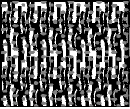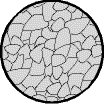
First, the Problems . . .
As with igneous and sedimentary rocks, metamorphic rocks are classified on the basis of texture (grain size, shape, orientation) and mineral composition. However, the classifiction of metamorphic rocks is more difficult to get into than with igneous and sedimentary rocks, for a couple of reasons. First, is the fact that metamorphism takes place through heat, pressure, and chemically active fluids, but there are many combinations of heat, pressure, and chemically active fluids and so there are many different responses.
Second, any rock - igneous, sedimentary, or metamorphic - can be a parent rock, and so the same heat/pressure/fluid combination can produce markedly different results depending on the type of parent. Or, to put it another way, there is not a direct relationship between the processes of metamorphism and the rocks that result - you have to understand each case on its own.
Third, totally different parent rocks undergoing the same kind of metamorphism can end up looking virtually the same. For example, greenschist (shale parent) and greenstone (mafic igneous parent).
Fourth, the texture terminology we use for metamorphic rocks is used to describe rocks that may have totally different parents, or may be metamorphosed under totally different conditions. The most common example is the term schist.
Schist is a type of layering or foliation found of metamorphic rocks where minerals large enough to be seen by eye tend to line up all in the same direction. But schistose rocks include Greenschist (chlorite dominated), Blueschist (glaucophane dominated, plus many other minerals), and just plain Schist (biotite or muscovite, quartz, and feldspar dominated), and each of these form under different tectonic conditions. To add confusion some rocks with a schist-like texture do not include the term in the name, like amphibolite.
Another example is the texture term gneiss. Gneissic rocks can be produced from both sedimentary and metamorphic parents, and not always under the same metamorphic conditions.
Then, the Solutions
The only way through the problems of metamorphic rock classification is to be very systematic. Once you understand a few basic concepts then we can systematically apply them to clear up some of the confusions. But, you must be clear and systematicFirst, we are going to handle each type of metamorphim - hydrothermal, contact, Barrovian, blueschist, eclogite. - separately. The advantage to this is that at the level we do it some types of metamorphism are pretty simple:
Eclogite, . . . produces the rock eclogite.
Contact, . . . produces the rocks hornfels and marble.
Blueschist, . . . produces the rock blueschist.
Hydrothermal, . . . produces rocks such as pegmatite, serpentinite, and soapstone.
Each of these rocks becomes a special case, and all you have to do is memorize them and you have it. Practically what this leave us with is Barrovian metamorphism which is complicated enough we have to deal with it separately.
Second, is to be absolutely clear about metamorphic textures. The same terms are used to describe rocks that come from totally different metamorphic processes, so we must avoid the mistake of assuming that a texture term refers to a particular type of metamorphism. No, a texture term only applies to a description of texture.
Metamorphic Rocks are divided into two basic divisions, summarized in the table below:
1. Foliated/Banded
2. Non-Foliated (also, granular or equidimensional).
FOLIATED |
NON-FOLIATED |
| Complex composition, many different kinds of minerals. | Simple composition, only a few minerals such as calcite or quartz. |
| Many new minerals produced with a change in T and/or P. | No new minerals form with a change in T and/or P. |
 Texture is layered, foliated, lineated, banded. Minerals have a preferred orientation.
Texture is layered, foliated, lineated, banded. Minerals have a preferred orientation. |
 Texture is granular and equi- dimensional.
No preferred orientation.
Texture is granular and equi- dimensional.
No preferred orientation.
|
| Many rocks with diverse compositions. See Barrovian metamorphism. | Few rocks with simple compositions. Qtz SS - Quartzite Limestone - Marble Dolostone - Dolomitic Marble Shale - Hornfels |
The granular rocks are not a big issue. There are a few of them, and we learn each one as a special case. The issue is with foliated textures. The textures themselves are not complicated, there are only three kinds (slaty cleavage, schistosity, and mineral banding) but their relationships to metamorphic processes can be complicated. So, . . . go on to